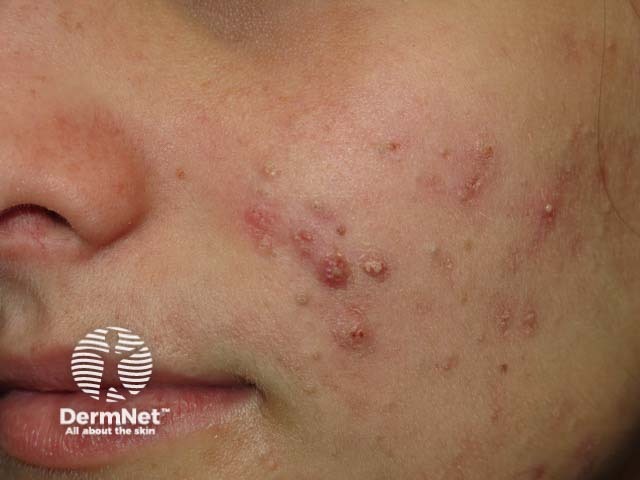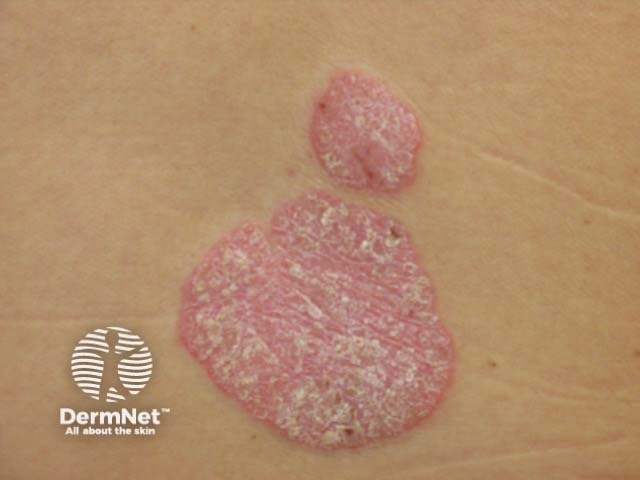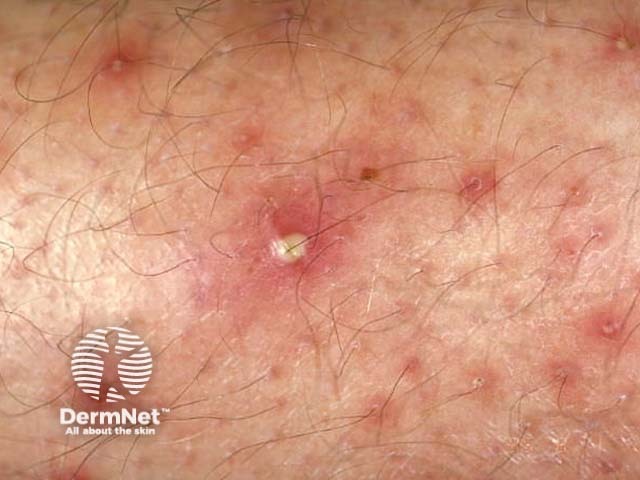Main menu
Common skin conditions

NEWS
Join DermNet PRO
Read more
Quick links
Lithium — extra information
Lithium
Author: Stewart Shiu, Fifth Year Medical Student, University of Auckland, New Zealand, May 2016.
Introduction Indications Onset of effects Adverse effects Monitoring Cutaneous adverse effects management Drug interactions Topical lithium
What is lithium?
Lithium is a chemical element and the lightest of the alkali metals. As it is highly reactive and flammable, it exists in nature in compounds. Lithium salts are used therapeutically in the treatment of mood disorders such as bipolar disorder and depression.
In New Zealand, lithium carbonate (a lithium salt) is fully subsidised and can be prescribed as 250 mg capsules, 250 mg or 400 mg tablets or 400 mg modified release tablets. Trade names include Lithicarb FC and Priadel. It is best taken with food to prevent nausea.
What is lithium used for?
Lithium is indicated for:
- Prevention and treatment of mania, hypomania and depression in bipolar disorder
- Prevention and treatment of recurrent unipolar depression
- Combination therapy with other antidepressants for the treatment of depression.
Lithium has been used for over 60 years and is a mainstay in both prevention and acute treatment of bipolar disorder. Many placebo-controlled trials have shown its efficacy in reducing the frequency and severity of both the manic and depressive phases of bipolar disorder. It has also been shown to reduce the risk of suicide and death compared to placebo.
How long does it take for lithium to work?
If used for acute mania and hypomania, patients will experience a therapeutic effect within 6–10 days. When used for depression, there is a 6–8-week delay in its effect. Used for prevention, it can take 6–12 months before the full therapeutic effect is achieved.
What are the adverse effects of lithium?
Lithium has a narrow therapeutic index, which means there is a small difference between doses that are effective for treatment and toxic doses. Because of this, regular blood tests are needed to check serum lithium levels. As lithium is excreted from the body through the kidneys, caution is required in patients with renal failure, as they are more likely to suffer from lithium accumulation and toxicity.
The adverse effects of lithium are usually dose-dependent and occur when serum lithium levels are above therapeutic levels.
Gastrointestinal side effects of lithium
Nausea, vomiting, anorexia and diarrhoea are more common in the initial stages of lithium therapy when serum lithium levels are not yet stable.
Neurological side effects of lithium
At therapeutic levels, lithium can cause a persistent fine hand tremor, muscle weakness and rarely, extrapyramidal features. Tremors may be treated with a beta-blocker. Patients with lithium toxicity may have impaired consciousness, apathy, hyperreflexia, hypertonia, seizures and rarely, death. Prolonged toxic exposure can lead to brain damage.
Endocrine side effects of lithium
Long-term lithium treatment, especially in middle-aged or older women, can result in hypothyroidism and euthyroid goitre, which responds well to treatment with supplementary thyroxine. Hypercalcaemia is reported in 10% of patients. Hypermagnesaemia and hyperparathyroidism have also been noted.
Renal side effects of lithium
Up to one-third of patients can develop nephrogenic diabetes insipidus, which presents as polyuria and polydipsia and is reversible on discontinuation of lithium. Long-term treatment on lithium can cause irreversible impairment of renal function.
Cardiac side effects of lithium
Lithium can cause ECG changes and arrhythmias due to QT prolongation. A recent myocardial infarction is a contraindication to lithium use.
Cutaneous adverse effects of lithium
The skin is the organ most commonly adversely affected by lithium.
- Men are more likely to be affected.
- Lithium has a higher rate of causing adverse skin effects compared to other psychotropic drugs used for mood disorders.
- Compared to other organ systems, adverse effects of the skin occur even if serum lithium is still in the normal therapeutic range.
It can cause the first presentation of a skin disease or can exacerbate an existing disease, such as psoriasis or acne.
- Not all patients with existing skin disease will flare up while on lithium.
- Exacerbations of pre-existing skin disease may become resistant to usual treatment. The skin condition is reversible if lithium is stopped, except in some cases of psoriasis. Some conditions such as folliculitis resolve, even while continuing lithium treatment.

Acne

Psoriasis

Folliculitis
Psoriasis
Psoriasis is a chronic inflammatory skin disease characterised by well-defined red and scaly plaques.
- On lithium, patients may develop new psoriasis at an average of 10 months after starting lithium or may develop an exacerbation of pre-existing psoriasis one month after starting lithium.
- Psoriasis tends to present in the scalp but may progress to generalised chronic plaque psoriasis.
- Lithium can also trigger other types of psoriasis, such as palmoplantar pustulosis, generalised pustular psoriasis, nail psoriasis and psoriatic arthritis.
- Upon discontinuing lithium, most cases of psoriasis improve within weeks.
Acne
Acne is a common inflammatory skin disease characterised by comedones (blocked hair follicles).
- It is the most common adverse effect of lithium.
- It usually appears several weeks after starting the drug.
- Lithium-induced acne appears as persistent monomorphic pustules on an erythematous base
- It usually arises on the limbs and trunk, rather than the face.
Folliculitis
Tender red pustules characterise folliculitis due to inflammation of hair follicles.
- Lithium-induced folliculitis tends to present on the extensor surfaces of the forearms and legs several months after initiating lithium.
- It resembles keratosis pilaris.
- Folliculitis self-resolves, even if lithium is continued.
Hair loss
Hair loss affects 12–19% of patients on long-term lithium therapy.
- It is more prevalent in women.
- Autoimmune hair loss may present as alopecia areata (round bald patches), or in some cases, alopecia totalis (the loss of all scalp hair).
- Hair loss may regrow when lithium is discontinued.
- Diffuse hair thinning may be due to lithium-induced hypothyroidism, so thyroid function should be measured.
Other skin diseases that have been reported in association with lithium include:
- Generalised morbilliform eruption and exfoliative dermatitis
- Cutaneous and mucosal/mouth ulcers
- Various forms of eczema/dermatitis
- Generalised pruritus and dry skin
- Pityriasis versicolor
- Darier disease
- Dermatitis herpetiformis and other immunobullous eruptions
- Hidradenitis suppurativa
- Drug-induced lupus erythematosus.
What investigations are undertaken while on lithium?
Patients on lithium should undergo regular tests of:
- Blood levels of lithium
- Renal and cardiac function
- Thyroid function tests.
Additional tests may be required, depending on the adverse effect observed, for example, skin biopsy or skin scrapings for mycology.
How are cutaneous adverse effects managed in patients on lithium?
For many patients, mood disorder may be more disabling than the skin condition, and lithium’s benefits may outweigh its side effects.
- Most adverse effects of the skin are mild to moderate in severity, and lithium can be safely continued. The skin condition is treated as usual with local and systemic treatments.
- If the skin condition is severe and not responding to treatment, reducing the dose of lithium or to stopping it may be considered.
Drug interactions with lithium
Numerous medications have been shown to interact with lithium and either increase or decrease the concentration of lithium in the body.
- The dose of lithium may need altering.
- The other medication may need to be stopped.
Examples include:
- Diuretics, ACE inhibitors and non-steroidal anti-inflammatories, which reduce excretion of lithium by the kidneys and can lead to an accumulation of lithium.
- Selective serotonin reuptake inhibitors (SSRIs), calcium channel blockers, tricyclic antidepressants and neuroleptics should be used with caution.
- Tetracycline antibiotics are often used to treat acne and rosacea, which can cause lithium toxicity.
- Lithium is contraindicated if taking another medication that causes QT prolongation, such as domperidone, hydroxyzine, mizolastine, piperaquine and sibutramine.
Topical lithium
Topical lithium salts are useful in the treatment of seborrhoeic dermatitis. It is believed to work by reducing the release of fatty acids in the skin. As fatty acids are important for growth in fungi, this reduces the number of fungi on the skin surface.
High local concentration of topical lithium also produces an anti-inflammatory effect, by reducing the production of prostaglandins and other eicosanoids. This allows it to be used to treat other inflammatory skin diseases.
Topical lithium is generally well tolerated and does not raise serum lithium levels significantly. It can cause transient mild skin irritation.
References
- Yeung CK, Chan HH. Cutaneous Adverse Effects of Lithium: Epidemiology and Management. Am J Clin Dermatol [Internet] 2004 [cited 2016 25 May]; 5 (1): 3–8. Available from http://link.springer.com.ezproxy.auckland.ac.nz/article/10.2165%2F00128071-200405010-00002
- M Heng. Cutaneous Manifestations of Lithium Toxicity. British Journal of Dermatology, [Internet] 1982 [Cited 2016 25 May];106: 107–9. Available from http://onlinelibrary.wiley.com.ezproxy.auckland.ac.nz/doi/10.1111/j.1365-2133.1982.tb00911.x/abstract
- 2014.06.9_Lithicarb[Internet] http://www.medsafe.govt.nz/profs/datasheet/l/LithicarbFCtab.pdf [Cited 2016 25 May]
- Interactions - NZF [Internet] http://nzf.org.nz/interactions/stockleys/of/10761281000116101 [Cited 2016 25 May]
- Cipriani A, Hawton K, Stockton S, Geddes JR. Lithium in the prevention of suicide in mood disorders: updated systematic review and meta-analysis. [Internet] BMJ. [cited 2016 25 May] 2013 Jun 27;346:f3646. Available from http://www.bmj.com/content/346/bmj.f3646
- Royal Australian and New Zealand College of Psychiatrists Clinical Practice Guidelines Team for Bipolar Disorder. Australian and New Zealand clinical practice guidelines for the treatment of bipolar disorder Aust N Z J Psychiatry.[Internet] 2004 [Cited 2016 25 May] May;38(5):280–305. Available from https://www.ranzcp.org/Files/Resources/Publications/CPG/Clinician/CPG_Clinician_Full_Bipolar-pdf.aspx
On DermNet
